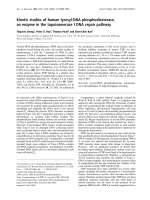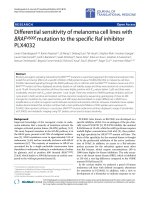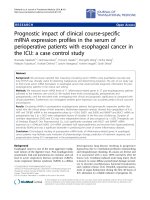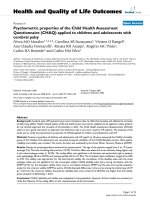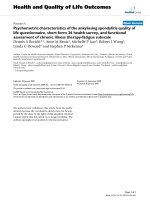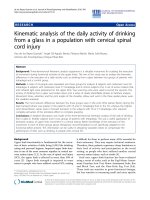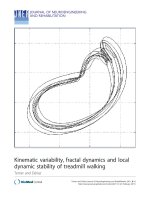báo cáo hóa học:" Kinematic assessment of hip movement when retrieving an object from the floor" ppt
Bạn đang xem bản rút gọn của tài liệu. Xem và tải ngay bản đầy đủ của tài liệu tại đây (676.15 KB, 7 trang )
RESEARC H ARTIC L E Open Access
Kinematic assessment of hip movement when
retrieving an object from the floor
Raheel Shariff
*
, Sunil Panchani, John D Moorehead, Simon J Scott
Abstract
Background: Activities that require extreme hip movement can dislocate hip implants in the early post operative
phase. One such activity is retrieving an object from the floor. The aim of this study was to assess hip movement
using four different techniques to accomplish this task. This assessment would identify the techniques least likely
to cause a hip dislocation.
Methods: An electromagnetic tracker was used to measure the movement of 50 hips in 25 normal subjects.
Sensors were attached over the iliac crest and the mid-shaft of the lateral thigh. Data was then collected for 3
repetitions of each of the following retrieval techniques:-
1. Flexing forward to pick up an object between the feet.
2. Flexing to pick up an object lateral to the foot.
3. Squatting to pick up an object between the feet.
4. Kneeling on one kne e to pick up beside the knee.
Results: Kneeling required a mean movement of 30.4 degree(s) flexion and 7.2 degree(s) external rotation. This
was sig nificantly les s than all the other techniques (paired t-test, P << 0.001). Squa tting required 87.4 degree(s)
flexion and 10.1 degree(s) internal rotation.
Conclusion: The study showed that squatting had the most flexion and internal rotation, whereas kneeling has
the least flexion. Thus, to minimise the dislocation risk when retrieving an object from the floor, kneeling should be
adopted and squatting should be avoided.
Background
Total Hip replacements significantly improve the quality
of life indices, with most patients returning to nor mal
activities within 6 weeks [1]. However, 2 to 11% [2] of
patients experience a post- operative dislocation. An
initial dislocation may lead to recurrent dislocations
causing a significant burden to the patient, surgeon and
the health service. Factors predisposing to dislocation
include patient compliance, implant positioning, elderly
age, excessive alcohol and revision surgery [3,4].
After surgery many patients expect a rapid return to
their normal activities of daily living (ADL’ s). However,
some of these activities require hip movement [5] that
increase the risk of joint dislocation. Thus, clinicians
usually advise patients to restrict these movem ents in the
early post operation phase [6]. The type of movement
depends upon the surgical approach used for the hip
implant. If a posterior approach was used then the patient
should avoid excessive flexion and internal rotation [7]. If
an anterior approach was used the patient should avoid
excessive extension and external rotation [7].
Bending to pick up an object from the floor is an ADL
that flexes the hip and poses a risk to posteriorly
implanted joints. The aim of this study was to assess hip
movement in normal subjects, using four different tech-
niques to accomplish this task. These techniques could
then be compared to see which one minimises the risk
of dislocation in patients with a total hip replacement.
We did not study patients with a total hip replacement
* Correspondence:
Orthopaedic Research Unit, University Hospital Aintree, Liverpool, L9 7AL, UK
Shariff et al. Journal of Orthopaedic Surgery and Research 2011, 6:11
/>© 2011 Shariff et al; licensee BioMed Central Ltd. This is an Open Access article distributed under the terms of the Creative Commons
Attribution License ( which permits unrestricted use, distribu tion, and reprodu ction in
any mediu m, provided the original work is properly cited.
in situ, as the 4 techniques used may theoretically put
them at risk of a dislocation.
Previous studies have investigated hip movement dur-
ing forward fl exion [8,9] and squatting [5]. Ho wever, we
believe our study is the first to compare various techni-
ques for retrieving an object from the floor.
Materials and methods
Study Design: Prospective study.
Ethical Committee Statement:
We state that our study has been approved by the
Regional ethics committee and therefore has been per-
formed in accordance with the ethical standards in the
1964 Declaration of Helsinki. All subjects gave their
informed consent before their inclusion in the study.
Power Calculation
To achieve a 5% significance level at a power of 0.80,
assuming a medium effect size and a repeated measures
design, it was calculated that a sample size of 24 would
be required to obtain a statistical difference between the
four techniques. A Student paired t-test was used.
Subjects
Following regional ethics committee approval a total of
25 he althy volunteers were recruited for this prospective
study. Strict inclusion and exclusion criteria were
adhered to for recruitment as documented below.
Inclusion criteria
Individuals > 18 years of age
Mobilising without a walking aid
Exclusion criteria
History of Developmental dysplasia of the hip
History of trauma/fractures to hips or spine
Adduction contractures to hips
History of surgery to hips or spine
History of low back pain
Instrumentation
A Polhemus Fastrak™ma gnetic tracking system was
used to measure hip mo vement . Previous studies [10,9]
have shown this tracker produces accurate and reprodu-
cible kinematic measurements.
The tracker consists of a 3- dimensional magnetic
source and small 3- dimensional magnetic sensors con-
nected to a computer. The source generated a small
magnetic field which was detected by t he sensors. One
sensor was attached around the femur over the lateral
aspect of the mid thigh. A second sensor was attached
over the pelvis by the iliac crest. Each sensor was
attached with a Velcro strap. It was then firmly
secured to the skin with adhesive tape. As the senso rs
move through the source field they output position ( X,
Y and Z) and orientation (Yaw, Pitch & Roll)
information to the computer at 12 Hz, with an accu-
racy of 0.15 degree.
The study was approved by the Regional Cheshire
ethics committee and therefore had been performed in
accordance with the ethical standards in the 1964
Declaration of Helsinki . All subjects gave their informed
consent before their inclusion in the study.
Procedure
The subjects were asked to stand upright with their
arms by the sides. The position of the hip joint was
recorded in this position and used a s the reference for
the subsequent movements. Hip movement was t hen
recorded using four different techniques to retrieve a
roll of tape from the floor. These techniques were:-
1. Flexing forward to pick up an object between the
feet (Technique 1 - Between)
2. Flexing to pick up an object on the lateral side of
the foot (Technique 2 - Side)
3. Squatting to pick up an object between the feet
(Technique 3 - Squat)
4. Kneeling on one knee to pick up beside the knee.
(Technique 4 - Kneel)
The techniques are illustrated in Figures 1, 2, 3 and 4.
Foot placement and the placement of the object were
standardized by marked reference points in the lab.
Three continuous cycles were recorded for each techni-
que in order to examine the repeatability of the move-
ment. Sensors were not removed during the recording
for each side. However they were checked in b etween
each set of movements to ensure they were firmly
attached. The procedure was the n carried out on the
contra lateral hip.
Typical “Flexion - Sample Number” plots are shown in
Figure 5. The plots show the hip flexions for one o f the
subjects retrieving an object from the floor using each
of the techniques. The 3 cycles are shown, and they
demonstrate good reproducibility for this subject. The Y
data shows the amount of hip flexion required, and the
× data shows the sample number, indicating time.
Kinematic analysis
Hip flexion, extension, internal rotation and external
rotation were analyzed for each of the four techniques.
The techniques were then compared to see which one
had maximal hip movements. Comparison was also
made between the left and right sides.
Results
Figures 6, 7, 8 and 9 show the mean hip flexion, exten-
sion, internal rotation and external rotation for all
50 hips (25 pairs), performing each of the retrieval tech-
niques. These plots also show the 95% confidence inter-
vals (CI95). Where there is no overlap between the CI95
Shariff et al. Journal of Orthopaedic Surgery and Research 2011, 6:11
/>Page 2 of 7
Figure 1 Pick up between feet.
Figure 2 Side pick up.
Figure 3 Squat pick up.
Figure 4 Kneel pick up.
Shariff et al. Journal of Orthopaedic Surgery and Research 2011, 6:11
/>Page 3 of 7
bars, there is a significant difference in movement.
Where there is an overlap, a paired t-test i s required to
determine significance.
Figure 6: When pick ing an object up between the feet,
the mean flexion on the left side was 79.8. degree(s) On
the right side it was 71.8 degree(s). This was the only
movement that demonstrated a left/right difference,
with a paired t-test P = 0.039. All oth er movements and
techniques showed no left/right differences. Comparing
flexion for each of the retrieval techniques, there was no
significant difference between technique 1 (Between)
and 2 (Side), paired t-test P = 0.08. Comparisons
betweentechniques1&3,1&4,2&3,2&4and3&
4 showed significant differences with P < 0.05.
Figure 7: For extension there was no significant left/
right difference for each technique. There was no signif-
icant extension difference between any of the groups
(P > 0.05).
Figure 8: For internal rotation there was no significant
left/right difference for each technique. There was no
significant internal rotation difference b etween techni-
ques 1 & 2 and 3 & 4. There were significant differences
between 1 & 3, 1 & 4, 2 & 3 and 2 & 4 (P < 0.05).
Figure 9: For external rotation there was no significant
left/right difference for each technique. There was no sig-
nificant external rotation difference between technique s
1 & 3. There were significant differences between techni-
ques 1 & 2, 1 & 4, 2 & 3, 2 & 4 and 3 & 4 (P < 0.05).
Typical Hip Flexion Plots
-10
0
10
20
30
40
50
60
70
80
90
0 100 200 300 400 500
Sam
p
le No.
Angle (Deg)
Between
Side
Squat
Kneel
Figure 5 Flexion plots for a typical subject using each of the retrieval techniques.
Flex Mean +/- CI95
0
20
40
60
80
100
120
1.Betw een 2.Side 3.S
q
uat 4.Kneel
Flex (degs)
Figure 6 Comparison of flexion.
Extension Mean +/- CI95
-2
-1
0
1
2
1.Betw een 2.Side 3.Squat 4.Kneel
Ext (degs)
Figure 7 Comparison of extension.
Shariff et al. Journal of Orthopaedic Surgery and Research 2011, 6:11
/>Page 4 of 7
Discussion
Flexion
Figure 6 shows the mean maximum hip flexion results.
Technique 1 (Between) was the only technique to show
a left/right difference, with P = 0. 039. When the left
hand w as used there was 79.8 degree(s) of left hip flex-
ion, when the right hand was used there was 71.8
degree(s) of right hip flexion. The reason for the
reduced hip flexion on the right side is unclear, but it
may be related to hand dominance, scapula protraction
and trunk rotation. For this movement the P value
(0.039) was approaching borderline significance. The
other techniques had no significant left/ri ght difference.
To simplify a comparison between techniques, Figure 6
shows the pooled left/right data for each technique.
Examination of the plots shows that technique 4 (kneel)
had the least flexion (30.4 degree(s)). This was followed
by techniqu e 1 (between) with 75.8 degree(s), technique
2 (side) with 79.2 degree(s) and technique 3 (squat) with
87.5 degree(s).
The mean peak flexion for technique 1 is similar to
reading s found in other studies which looked at forward
flexion [8,11]. Extreme forward flexion is a movement
from which patients in the early post-operative period
are protected. This is done mainly by technique modifi-
cation education conducted by physiotherapists during
rehabilitation. This minimises femoral neck impinge-
ment on the acetabular lip, and thus dislocation [12].
Khan et al conducted a multi-centre study and found
that 31 out of a total of 142 dislocations occurred due
to forward flexion (22%) [3].
In initial visual observations it appeared that technique 1
(between) had the most flexion. However, a full analysis of
the measured data showned that technique 3 (squat) has
the most flexion (87.5 degree(s)). This surprising result
may be explained by the coupled movement of the lumbar
spine and hip joint aiding flexion in technique 1 [8].
Kneeling had the least flexion and therefore poses the
least risk of hip dislocation.
Extension
Figure 7 shows the mean maximum hip ext ension
results for each technique. It shows that none of the
techniques requir ed significant extension past the neu-
tral reference position. Technique 4 (kneel) had the
most extension (0.4 degree(s)). Extension is a risk factor
for hips implanted with an an terior approach [7]. These
small extensions should not pose a significant disloca-
tion risk to patients.
Internal Rotation
Figure 8 shows the mean maximum internal rotation
results. Techniques 2 (side) and 1 (between) had the
least internal r otation, with values of 1.4 degree(s) and
2.9 degree(s) respectively. Techniques 4 (kneel) and 3
(squat) had the most internal rotation, with values of
8.5 degree(s) and 10.2 degree(s) respectively.
Technique 3 (squat), also had the most flexion. Flex-
ion coupled with internal rotation can predispose a hip
to dislocation when it has been implanted with a poster-
ior approach [7]. Our results indicate that this technique
should be avoided to minimise the dislocation risk.
Technique 4 (kneel) had the least flexion. Although
it’s internal rotation was greater than techniques 1 and
2, its minimal flexion makes it safer than the other
three techniques.
External Rotation
Figure 9 shows the mean maximum external rotation
results. Technique 4 (kneel) had the least external rota-
tion with 7.3 degree(s). Techniques 3 (squat) and 1
(between) had external rotations of 11.9 degree(s) and
Int Rot Mean =/- CI95
0
2
4
6
8
10
12
14
1.Betw een 2.Side 3.Squat 4.Kneel
Int Rot (degs)
Figure 8 Comparison of internal rotation.
Ex t Rot Mean +/- CI95
-25
-20
-15
-10
-5
0
1.Betw een 2.Side 3.Squat 4.Kneel
Ext (degs)
Figure 9 Comparison of external rotation.
Shariff et al. Journal of Orthopaedic Surgery and Research 2011, 6:11
/>Page 5 of 7
12.7, degree(s) respectively. Technique 2 (side) had the
most external rotation, with 20.1 degree(s). External
rotation mainly poses a risk to patients with a hip
implanted via an anterior approach. The greatest risk
occurs when the external rotation is coupled with hip
extension. As there was very little extension past neutral
for any of the techniques, it is unlikely that the recorded
external rotations will pose a significant dislocation risk.
Spinal movement
Each of the retrieval techniques also required spinal
movement coupled to the hip movement. Esola et al
described the patter n of motio n during forward flexion
by calculating lumbar to hip flexion ratios [8]. For normal
subjects they found that in early flexion (0-30 deg ree(s)) ,
the lumbar-hip flexion ratio was 1.59. In mid flexion
(30-60 degree(s)) the ratio was 1.06. In late flexion (60-90
degree(s)) the ratio was 0.49. Thus in early flexion, the
lumbar spine contribu ted more than the hip. In late flex-
ion, the hip contributed more than the lumbar spine.
They concluded that both the lumbar spine and hip joint
contribute to bending forward movement, but the lumbar
spine mainly contributes to the early part of this move-
ment. In patients with low back pain this ratio was
increased. As patients with back pain were excluded from
our study, we assume that the lumbar spine played its
normal role in the bend forward manoeuvre.
Other high risk activities
Retreiving an object from the floor in the early post
operative period can be considered a high risk activity
given the amount of hip movement involved. Meek et al
looked at the epidemiology of hip dislocations and
recommended that high risk activities should be avoided
for at least one year post operative [6]. Hip dislocation
has been c lassified as a result of patient position, soft
tissue i mbalance and component malposition [13]. Nad-
zadi et al studied the kinematics of activities of daily liv-
ing which pre-dispose to dislocation. They found that
standing from a low seated position had the highest risk
of posterior dislocation. This was followed by standing
from a seated position at normal height [14]. In another
study Hemmerich et al found that high ranges of hip
movements were not provided by most currently avail-
able prosthesis in the market.
Conclusion
The aim of this study was to study and suggest the pos-
tural method of retrieving an object from the floor for
patients undergoing total hip replacement surgery.
The present study provides useful information on the
normal kinematics of hip joint movements when retriev-
ing an object from the floor. The technique most at risk
of dislo cation is squ atting. The tech nique with the least
risk of dislocation is kneeling. From these results it is
recommend t hat kneeling is adopted for post operative
rehabilitation and mobili sation protocols, following total
hip arthroplasty.
Consent
Written informed consent was obtained from the patient
for publication of this article and accompanying images.
A copy of the written consent is available for review by
the Editor-in-Chief of this journal.
Authors’ contributions
The authors have all read and agree with the manuscript. RS drafted the
protocol, sought ethical approval, collected data, helped in analysis and
drafted the manuscript. SP helped collect data, analyse and draft the
manuscript. JM participated in drafting the protocol, collecting data, analysis,
statistics and drafting the manuscript. SJS helped draft the protocol and
prepare the manuscript.
Competing interests
The authors state that they have no financial relationship with the
organization that sponsored the research. We also state that we have full
control of all primary data and that we agree to allow the journal to review
our data if requested. ‘The author(s) declare that they have no competing
interests’.
We have not received reimbursements, fees, funding, or salary from an
organization that may in any way gain or lose financially from the
publication of this manuscript, either now or in the future.
The authors do not hold any stocks or shares in an organization that may in
any way gain or lose financially from the publication of this manuscript,
either now or in the future
The authors are not currently applying for any patents relating to the
content of the manuscript. Have not received reimbursements, fees, funding,
or salary from an organization that holds or has applied for patents relating
to the content of the manuscript
Non-financial competing interests
The authors do not have any non-financial competing interests (political,
personal, religious, ideological, academic, intellectual, commercial or any
other) to declare in relation to this manuscript.
Received: 19 April 2010 Accepted: 21 February 2011
Published: 21 February 2011
References
1. Sinici E, Tunay S, Tunay V, Kilic E: Evaluation of patient quality of life after
total hip arthroplasty. Acta Orthop Traumatol Turc 2008, 42(1):22-5.
2. Grigoris P, Grecula MJ, Amstutz HC: Tripolar hip replacement for recurrent
prosthetic dislocation. Clin Orthop and Relat Res 1994, , 304: 148-55.
3. Ali Khan MA, Brakenbury PH: Reynolds ISR: Dislocation following total hip
replacement. JBJS Br 1981, 63-B(2):214-18.
4. Woolson ST, Rahimtoola ZO: Risk factors for dislocation during the first 3
months after primary total hip replacement. J Arthroplasty 1999,
14(6):662-8.
5. Hemmerich A, Brown H, Smith S, Marthandam SS, Wyss UP: Hip, knee, and
ankle kinematics of high range of motion activities of daily living. Jof
Orthop Res 2006, 24(4):770-781.
6. Meek RMD, Allan DB, cPhillipsG M, Kerr L, Howie CR: Late dislocation after
total hip arthroplasty. Clin Med Res 2008, 6(1):17-23.
7. Tanino H, Ito H, Harman MK, Matsurio T, Hodge WA, Banks SA: An in vivo
model for intraoperative assessment of impingement and dislocation in
total hip arthroplasty. J Arthroplasty 2008, 23(5):714-20.
8. Esola MA, McClure PW, Fitzgerald GK, Sieglar S: Analysis of lumbar spine
and hip motion during forward bending in subjects with and without a
history of low back pain. Spine 1996, 21(1):71-8.
9. Lee RY, Wong TK: Relationship between the movement of the lumbar
spine and hip. Hum Mov Sci 2002, 21(4):481-94.
Shariff et al. Journal of Orthopaedic Surgery and Research 2011, 6:11
/>Page 6 of 7
10. An KN, Jacobsen MC, Berrglund LJ, Chao EYS: Application of a magnetic
tracking device to kinesiologic studies. J Biomech 1988, 21(7):613-20.
11. Pal P, Milosavljevic S, Sole G, Johnson G: Hip and lumbar continous
motion characteristics during flexion and return in young healthy males.
Eur Spine J 2007, 16(6):741-7.
12. Scifert CF, Brown TD, Pederson DR, Calaghan JJ: A finite element analysis
of factors influencing total hip dislocation. Clin Orthop and Relat Res 1998,
, 355: 152-62.
13. Dorr LD, Wolf AW, Chandler R, Conaty JP: Classification and treatment of
dislocations of total hip arthroplasty. Clin orthop and Relat Res 1983, , 173:
151-8.
14. Nadzadi ME, Pederson DR, Yack HJ, Callaghan JJ, Brown TD: Kinematics,
kinetics and finite element analysis of commonplace manouvers at risk
of total hip dislocation. J Biomech 2003, 36(4):577-91.
doi:10.1186/1749-799X-6-11
Cite this article as: Shariff et al.: Kinematic assessment of hip movement
when retrieving an object from the floor. Journal of Orthopaedic Surgery
and Research 2011 6:11.
Submit your next manuscript to BioMed Central
and take full advantage of:
• Convenient online submission
• Thorough peer review
• No space constraints or color figure charges
• Immediate publication on acceptance
• Inclusion in PubMed, CAS, Scopus and Google Scholar
• Research which is freely available for redistribution
Submit your manuscript at
www.biomedcentral.com/submit
Shariff et al. Journal of Orthopaedic Surgery and Research 2011, 6:11
/>Page 7 of 7
